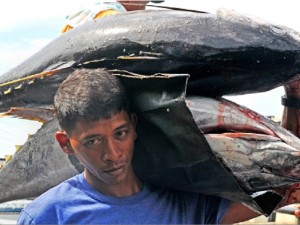
Fisherman carries large size of Tuna Fish as they transfer from Tuna Port to Public Market in General Santos City. ANDREW TADALAN/ FILE PHOTO
MANILA, Philippines—The government hopes to replenish fish populations in key marine areas around the country through a program called “Ecofish,” a joint project with the United States Agency for International Development (USAID).
Short for Ecosystems Improved for Sustainable Fisheries, the Ecofish project was launched on Wednesday by the Department of Agriculture, Bureau of Fisheries and Aquatic Resources (BFAR) and USAID to improve the management of Philippine coastal and marine resources.
The objective is to make the fisheries sector sustainable through the effective management of eight important biodiversity areas. These areas are the Calamianes Group of Islands in Palawan, Lingayen Gulf in Pangasinan, Ticao Pass-Lagonoy Gulf-San Bernardino Strait in Bicol and Samar, Danajon Double Barrier Reef in Bohol and Leyte, southern Negros Occidental, Surigao, Sulu archipelago, and the Verde Island Passage between Batangas and Mindoro.
Agriculture Secretary Proceso Alcala said Ecofish was designed to contribute to priority goals laid out in the Philippine Development Plan, particularly the conservation and rehabilitation of natural resources.
At the launch of the five-year Ecofish project, Alcala, who was joined by BFAR Director Asis Perez and USAID’s Environment Chief Rolf Anderson, said the government was paying more attention now to the fisheries sector.
He noted that the 2013 budget for fisheries was raised to P4.6 billion to enable the BFAR to rebound and improve its performance, following stagnant production in past years.
Alcala said part of the fund will be used to align methods and systems necessary to “bring the sector back into shape.”
As part of efforts to replenish fish populations, Alcala earlier announced a closed season for harvesting sardines, herring and mackerel in the Visayas Sea from Nov. 15, 2012 to Feb. 15, 2013.
“When there are more sardines in the ocean, tuna species tend to stay longer in our territorial seas, which eventually result in bigger harvest,” he explained.


